
 |
people managementveryard projects > people management |
| we offer | questions of people management | on this page | links |
| consultancy - assessments,
planning & facilitation
education & training - coaching & mentoring presentations |
How to satisfy the aspirations and development needs
of the people working in the organization.
How to establish conguence between the demands placed on people, and the capabilities and resources available to them. (Seems obvious, doesn't it? But many managers, particularly in the software industry, need help with the details.) |
On this page, we discuss two public domain frameworks
for people management.
The Software Engineering Institute, best known for its Capability Maturity Model for Software, has also produced a Capability Maturity Model for People Management. Veryard Projects has developed a simple explanation of the structure of the People Management CMM, which shows how feedback loops are used to increase integration at each level. People management is also an important component of the evaluation model for the European Quality Award, administered by the European Foundation for Quality Management. |
 |
SEI Capability Maturity Model for People (P-CMM)
veryard projects > people
management > p-cmm |
Like the better-known Software CMM, the People
CMM has five levels. Level 1 represents a general lack of capability. For
each level above 1, there is a set of process areas that have to be mastered.
| Level 2: Repeatable
|
Level 3: Defined
|
Level 4: Managed
|
Level 5: Optimizing
|
Each process area maintains a match between two
important elements of people management. As we shall see, these elements
connect to form a network, which only becomes complete when we reach Level
5.
| There are six process areas in Level
2. I have drawn them as white double rectangles.
Each of these process areas focuses on achieving a good match between two characteristics of People Management. I have drawn these characteristics as blue ovals. Level 2 is all about Performance. The six components of Level 2 can be drawn as a hierarchy, with Performance at the top. |
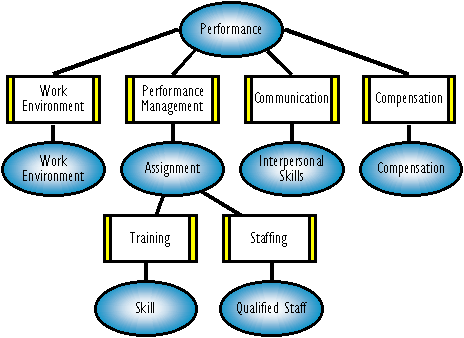 |
| Process Area | Match Between | Positive Indicators | Negative Indicators |
| Work Environment | Work Environment
Performance |
Appropriate work environment exists
Improvements are made to enhance performance |
Excessive, unnecessary, inappropriate
distractions
Non-compliance with applicable laws and regulations |
| Communication | Interpersonal skills
Performance |
Social environment supports effective
interaction
Effective mechanisms for top-down and bottom-up communication. Workforce skills
|
Meetings bloody meetings
Email bloody email Unresolved problems, conflicts or grievances |
| Staffing | Assignment
Qualified Staff |
Effective recruitment
Effective selection Effective transitioning (= staff deployment) |
Lack of coordination in staffing activities
Unclear criteria for recruitment, selection and transitioning |
| Performance Management | Performance
Assignment |
Objective performance criteria
Continuous performance monitoring and enhancement of unit and team. |
Vague or subjective performance criteria |
| Training | Skill
Assignment |
||
| Compensation | Compensation
Performance |
| At Level 3, there are three process
areas that make a loop. These are shown at the top of the diagram.
Three further process areas connect into this loop. |
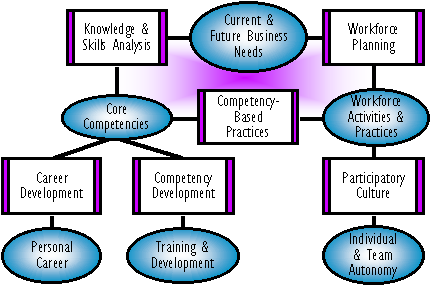 |
| Process Area | Match Between | Positive Indicators | Negative Indicators |
| Knowledge and Skills Analysis | Identified core competencies, knowledge
& skills
Current and future business needs |
Core competencies are known.
Required knowledge and skills are known. |
|
| Workforce Planning | Workforce activities
Current and future business needs |
||
| Competency Development | Core Competencies
Training and development |
||
| Career Development | Core Competencies
Personal Career |
Individual motivation and opportunities to develop new skills and enhance career prospects. | Mismatch between organizationís core competencies and personal career plans, opportunities and histories. |
| Competency-Based Practices | Core competencies
Workforce practices |
Workforce practices for recruitment and staffing, workforce assignment, and performance criteria and compensation are aligned with core competencies. | Workforce practices for recruitment and staffing, workforce assignment, and performance criteria and compensation are not aligned with core competencies. |
| Participatory Culture | Workforce Activities & Practices
Individual and Team Autonomy |
Flow of information within the organization.
Individual knowledge incorporated into decision-making processes. Individual support for commitments. |
Lack of organization back-up for empowerment.
Required information not made available. Frequent override by higher management. |
| At Level 4, we introduce a crucial distinction between performance results and performance goals. | 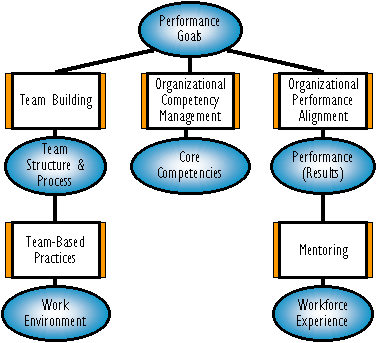 |
| Process Area | Match Between | Positive Indicators | Negative Indicators |
| Mentoring | Performance Results
Workforce Experience |
Support for mentors
Preparation and guidance Meetings for mentors to share experiences and problems |
Coerced participation in mentoring
programme
Mentors overstepping defined boundaries |
| Team Building | Team Structure & Process
Performance Goals |
Integration of diverse knowledge and
skills within teams
Clear terms of reference
|
Conflict within team
Group-think within team |
| Team-Based Practices | Team Structure & Process
Work Environment |
Development, motivation and functioning
of teams consistent with work environment and organizational workforce
practice.
Individual compensation aligned with team criteria. |
Work environment interferes with team
functions.
Individual compensation misaligned with team criteria. |
| Organizational Competency Management | Organizationís capability (core competency)
Performance goals |
||
| Organizational Performance Alignment | Performance results
Performance goals |
| Level 5 concentrates on workforce practices. | 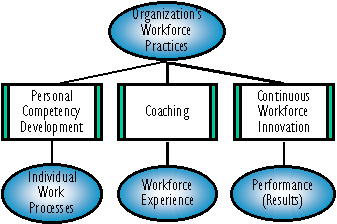 |
| Process Area | Match Between | Positive Indicators | Negative Indicators |
| Personal Competency Development | Workforce Practices
Individual Work Processes |
Personal self-development
Planning Measuring performance Setting improvement targets Defining and improving individual work processes |
Individual work process improvement not supporting or supported by organizationís workforce practices. |
| Coaching | Workforce Practice
Workforce Experience |
Defined criteria for assignment of
coaches to teams and individuals
Rewards for coaches and coachees. |
Responsibilities (and authority) of
coach are unclear
Lack of demonstrable benefits from coaching |
| Continuous Workforce Innovation | Performance Results
Workforce Practices |
Systematic evaluation of innovative
practices and technologies
Empowerment to improve activities
|
Isolated pockets of innovation - lack
of dissemination
Inertia in workforce practices |
| Here are the level 2 process areas again. | 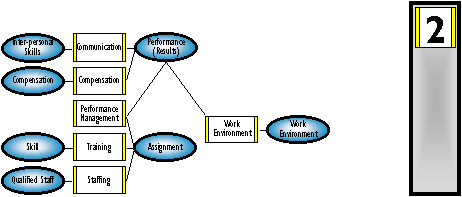 |
| Now we add the level 3 process areas.
There is no connection between them. |
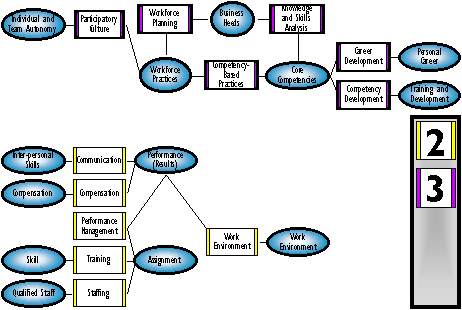 |
| Level 4 connects Level 2 with Level
3.
Note the emergence of a loop
|
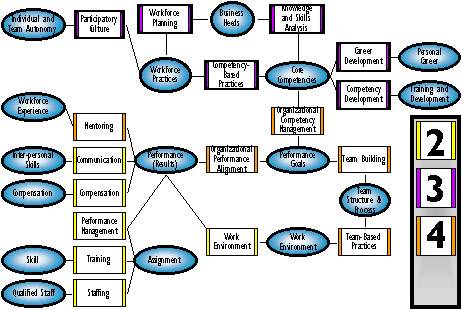 |
Finally, level 5 completes the central
loop
|
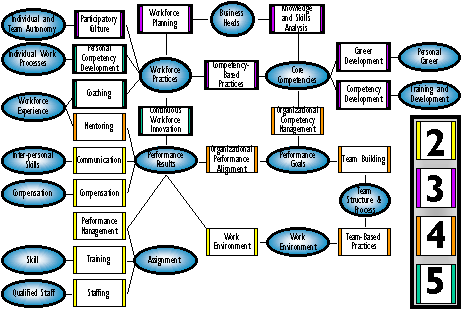 |
 |
How does the European Quality Award address people management?veryard projects > people management > efqm |
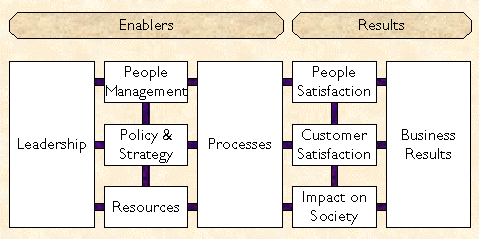
 |
People Management - Further Materialsveryard projects > people management > related materials |
| Quality management / process improvement
Project / programme management People issues in process improvement: encouraging, enabling, empowering |
|
| SEI Capability Maturity Model for People (P-CMM) |
| top |  |
|
Copyright © 1997-2001 Veryard Projects Ltd http://www.veryard.com/sqm/pcmm.htm |